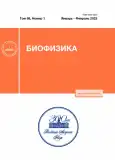Comparison of the dynamics of DNA damage in blood leukocytes and survival of mice after total body irradiation with Bragg peak carbon ions or x-rays
- Autores: Kuznetsova E.A1, Rozanova O.M1, Smirnova E.N1, Glukhov S.I1, Sirota T.V1, Belyakova T.A2, Sirota N.P1
-
Afiliações:
- Institute of Theoretical and Experimental Biophysics, Russian Academy of Sciences
- Physical-Technical Center of Lebedev Physical Institute, Russian Academy of Sciences
- Edição: Volume 68, Nº 1 (2023)
- Páginas: 112-119
- Seção: Articles
- URL: https://journals.rcsi.science/0006-3029/article/view/144410
- DOI: https://doi.org/10.31857/S000630292301012X
- EDN: https://elibrary.ru/OALBXD
- ID: 144410
Citar
Texto integral
Resumo
Sobre autores
E. Kuznetsova
Institute of Theoretical and Experimental Biophysics, Russian Academy of Sciences
Email: kuzglu@rambler.ru
Pushchino, Moscow Region, Russia
O. Rozanova
Institute of Theoretical and Experimental Biophysics, Russian Academy of SciencesPushchino, Moscow Region, Russia
E. Smirnova
Institute of Theoretical and Experimental Biophysics, Russian Academy of SciencesPushchino, Moscow Region, Russia
S. Glukhov
Institute of Theoretical and Experimental Biophysics, Russian Academy of SciencesPushchino, Moscow Region, Russia
T. Sirota
Institute of Theoretical and Experimental Biophysics, Russian Academy of SciencesPushchino, Moscow Region, Russia
T. Belyakova
Physical-Technical Center of Lebedev Physical Institute, Russian Academy of SciencesProtvino, Moscow Region, Russia
N. Sirota
Institute of Theoretical and Experimental Biophysics, Russian Academy of SciencesPushchino, Moscow Region, Russia
Bibliografia
- O. Mohamad, B. J. Sishc, J. Saha, et al., Cancers, 9, 66 (2017). doi: 10.3390/cancers9060066
- M. Moreno-Villanueva, M. Wong, T. Lu, et al., npj Microgravity, 3, 14 (2017). doi: 10.1038/s41526-017-0019-7
- I. Vavitsas and K. Kalachani, AIP Conf. Proc., 2075, 200018 (2019). doi: 10.1063/1.5099028
- S. Muralidharan, S. P. Sasi, M. A. Zuriaga, et al., Front. Oncol., 5, 231 (2015). doi: 10.3389/fonc.2015.00231
- E. I. Azzam, J. P. Jay-Gerin, and D. Pain, Cancer Lett., 327, 48 (2012). doi: 10.1016/j.canlet.2011.12.012
- A. R. Collins, A. A. Oscoz, G. Brunborg, et al., Mutagenesis, 23 (3), 143 (2008).
- E. A. Kuznetsova, N. P. Sirota, I. Y. Mitroshina, et al., Int. J. Radiat. Biol., 96 (10), 1245 (2020). doi: 10.1080/09553002.2020.1807640
- E. A. Kuznetsova., A. R. Dyukina, I. A. Chernigina, et al., Bull. Eksperim. Biologii i Meditsiny, 155 (6), 757 (2013). doi: 10.1007/s10517-013-2245-7
- N. K. Chemeris, A. B. Gapeyev, N. P. Sirota, et al., Mutat. Res., 558, 27 (2004).
- D. P. Lovell and T. Omori, Mutagenesis, 23 (3), 171 (2008).
- K. Datta, S. Suman, B. V. Kallakury, et al., PLoS One, 7 (8), e42224 (2012). doi: 10.1371/journal.pone.0042224
- А. И. Газиев, Радиационная биология. Радиоэкология, 39 (6), 630 (1999).
- M. H. Lankinen, L. M. Vilpo, and J. A. Vilpo, Mutat. Res., 352 (1-2), 31 (1996).
- J. M. Danforth, L. Provencher, and A. A. Goodarzi, Front. Cell Dev. Biol., 10, 910440 (2022). doi: 10.3389/fcell.2022.910440
- S. Kobashigawa, K. Suzuki, and S. Yamashita, Biochem. Biophys. Res. Commun., 414, 795 (2011).
- K. I. Matsumoto and M. Ueno, Y Shoji et al., Free Radic. Res., 55 (4), 450 (2021). doi: 10.1080/10715762.2021.1899171
- D. Averbeck and C. Rodriguez-Lafrasse, Int. J. Mol. Sci., 22 (20), 11047 (2021). doi: 10.3390/ijms222011047.
- R. B. Richardson and M. E. Harper, Oncotarget, 7 (16), 21469 (2016). doi: 10.18632/oncotarget.7412
- N. Chatterjee and G. C. Walker, Environ. Mol. Mutagen., 58 (5), 235 (2017). doi: 10.1002/em.22087
- http://www.andreevka.msk.ru/product.htm
- W. Tinganelli and M. Durante, Cancers (Basel), 12 (10), 3022 (2020). doi: 10.3390/cancers12103022
Arquivos suplementares









